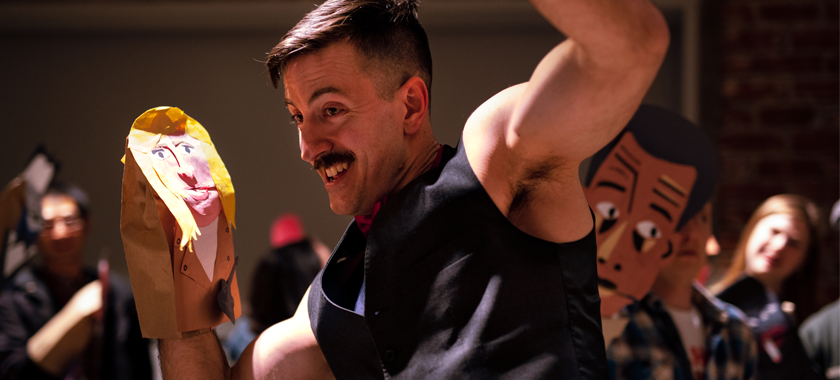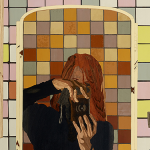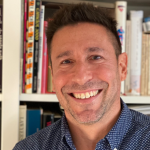The Advantages of Living in Smaller, Nimbler Cities
There is opportunity—and community—in cities that aren’t New York or Los Angeles. Hear how writer, editor, performer, and visual artist Karl Jones is realizing his creative visions in Tulsa, OK through the Tulsa Artist Fellowship.
Karl Jones makes performance and visual work while writing and editing children’s literature for Penguin Random House. Originally from Tulsa, he lived in the Baltimore, MD/Washington, DC area and Brooklyn, NY before returning to Oklahoma to join the Tulsa Artist Fellowship in 2019. Designed to provide sustainability for professionally-established artists and arts workers of any medium or discipline, the Fellowship includes a $40,000 stipend and living and studio space in Tulsa’s Arts and Greenwood Districts for two years. The program, which is merit-based and not project-focused, is currently accepting applications for their 2021-2023 cohort now through Friday, January 15. Learn more about Jones’ experience in the program and how building a sustainable arts career is possible in cities like Tulsa.
NYFA: What advantages are there in living outside of an art world center, and can you describe Tulsa’s creative community for those who may not be familiar?
Karl Jones: Tulsa is a beautifully complex city with a past that exemplifies some of the worst impulses in American history. But there is an excitement here in the community’s desire to be honest with itself. And I’ve always found that humility is a better starting point for making great art than pride.
I think the frequently discussed financial and spatial advantages afforded to those living and working in less dense, less expensive cities cannot be overstated. In addition to the practical realities of having more space, and potentially more time, there is a psychic freedom that westward moving American artists have advocated for decades. Coupling this with recent technological abilities to stay engaged in dynamic art conversations without being physically present makes a solid case for maintaining a good practice in smaller, nimbler cities.
NYFA: What is the single most important thing—related to your arts practice ideally—that you’ve learned since moving back to Tulsa to participate in the program?
KJ: If I had to pick one thing it would be the realization that my practice can struggle in a vacuum, and that this void can exist in busy places without me realizing it. I often fetishize the New York City art world of the 70s, 80s, and 90s, with the special density it afforded to artists willing to come to a broken city and be a part of that creative experiment. Everyone knew everyone and everyone was ready to collaborate. But I think that scale is difficult to create in New York City now, especially without significant financial means. And that level of dense engagement is surprisingly available in smaller cities, but it requires a different relationship to creative practice than the one represented in the dominant narrative we’ve cultivated about being an artist.
NYFA: What has surprised you most about the program and Tulsa?
KJ: I’ve worked for and with arts organizations throughout the United States and I’ve never seen an organization anticipate the needs of working artists with the empathy and awareness that the fellowship does.
As for the ways Tulsa surprises, I could think of many. Tulsa has the second largest urban American Indian population, representing dozens and dozens of local tribes. The cultural diversity represented in this citizenry is often ignored in national media, but the dynamic role indigenous artists, arts workers, and arts audiences play in the culture of Oklahoma’s arts institutions is a welcome surprise for many friends of mine who visit from elsewhere.
And as a queer artist, I can’t leave out how constantly surprised I am by how conversations around art, politics, and identity are evolving so similarly at this point in history no matter where you are. I remember seeing Luca Lucas cast in Don Giovanni at the Tulsa Opera in 2019. It was the first time a trans woman had been cast in a professional opera in the United States. The palpable excitement of the largely queer audience was not dissimilar to what I’d experienced the previous year when Lauren Lovette and Justin Peck* choreographed their respective same sex pas de deux at the New York City Ballet.
NYFA: What advice might you give to folks who are considering a move outside of more established art world hubs like New York and Los Angeles?
KJ: Don’t colonize your new city with “good art” or “good politics.” Find the people who have been making art and creating change for decades and begin conversations with them. Find ways to make your art practice relevant and helpful to the community.
*Editor’s Note: Justin Peck received a NYSCA/NYFA Artist Fellow in Choreography in 2013
This post is part of a regular series highlighting #NYFAPartner sponsor organizations on NYFA’s blog. Follow NYFA on Twitter, Facebook, LinkedIn, and Instagram to see the latest news about each #NYFAPartner. Sign up for NYFA’s bi-weekly newsletter, NYFA News, to receive announcements about future NYFA events and programs.





